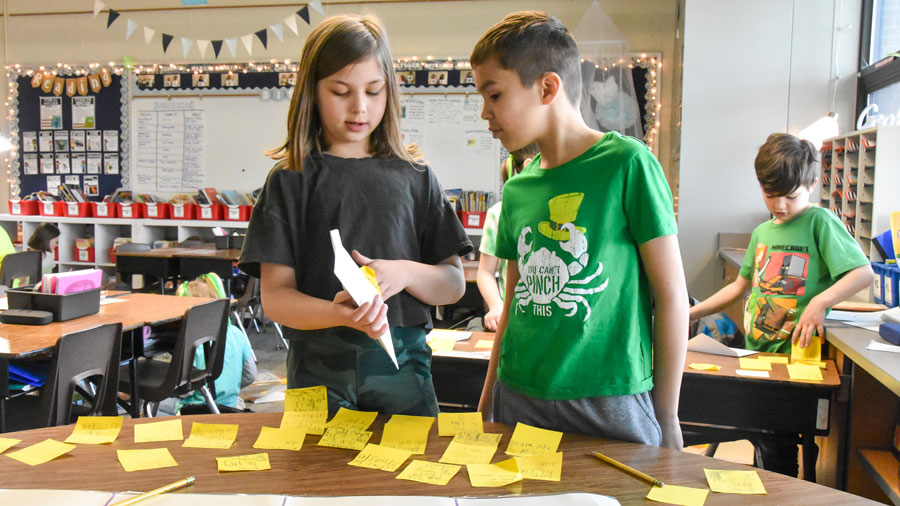Rockford — Gabby Kulak sat on the floor in her second-grade classroom at Parkside Elementary, yellow sticky notes strewn about in front of her. At her side were a handful of blank envelopes, three with handwritten labels on them: “fun facts,” “communications” and “types of wolves.”
She furrowed her brow as she shuffled through the sticky notes again, reading what she had written on each one.
“I might need some more envelopes, because I have so many notes,” Gabby said, partially to herself and partially to explain her process to a visitor. “We read a lot of books, so we have a lot of notes. Like this one—” she grabbed a note from the pile and held it up — “we read that wolves howl to stay in touch with each other, so we wrote it down.”
Gabby and her project partner (who was absent that day) chose to do research on wolves as part of teacher Tori Fowler’s informational book club unit.
“We were very curious about wolves because we wanted to learn how dangerous they are and about their habitat,” Gabby explained.
The project gave students experience reading nonfiction, doing research on a topic, categorizing information, working with a partner and giving a public presentation.

“My most important thing as a teacher is creating purposeful learning,” Fowler said. “Oftentimes a reading unit can be just, like, we read and take notes and then we move on. I want there to be a purpose, a culminating experience at the end of the unit, so that as they’re reading, they are working toward making a presentation to (the other second-grade classroom).”
Fowler began the project by introducing research and note-taking skills. As the students read about their chosen nonfiction topics, they worked to collect evidence from the text, record page numbers, summarize information and learn how to paraphrase what they learned into easily digestible tidbits.
That’s where the sticky notes came in. On this particular day, the second-graders were learning how to categorize all the data they had collected from their research. Their task was to separate all of their sticky notes into categories based on topic, and then come up with an appropriate header – such as Gabby’s “types of wolves” – for each section of their Google presentation.
“Categorizing can be a really hard piece of this — the idea of organizing their thinking, what they’ve read and everything they’ve written down,” Fowler said. “Right now what they have is so random, like everything from food to habitat to sounds. This helps get them thinking on how they’re going to present all of this information.”

Hibernation and Other Connections
In one corner of the room, project partners Demetrio Zuber and Ruby Peplinski were working together to sort through their notes about their chosen topic, bears. They had already come up with topic headers like “where they eat” and “where they live,” when Demetrio began talking with a visitor about how bears like to sleep.
That’s when Ruby picked up one of her sticky notes. The topic? Hibernation.
“Oh yeah, that’s why bears sleep so much in the winter, is because of hibernation,” Demetrio exclaimed. And just like that, they had another header to add.
After class, Fowler reflected on that moment: “It was so cool to see them noticing those connections — this thing that one person learned can connect to something I was thinking about, and we can put it all together. I loved seeing all the different ways that each group was categorizing their information.”
Upon finalizing their headers, students started creating their presentations in Google Slides, adding those headers into the document. The next phase of the project was to add text features including captions, diagrams, photos and other tidbits.
After everything was finalized, Fowler’s students were going to present what they’ve learned to small groups in Parkside’s other second-grade class.
“They’re super-excited to share what they’ve learned,” Fowler said. “Reading nonfiction is so hard; I love to see at the end of this that they can take and analyze information. Then you have something interactive, the public speaking piece, and everything gets incorporated together — it’s great to give them a goal to work toward. I think it’s so important to give students these kinds of opportunities.”










